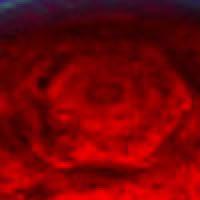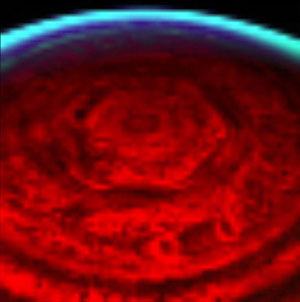
Polygons in space
We may not have found other life in our Solar System, but we have, it appears, found a polygon. An odd, six-sided, honeycomb-shaped feature circling the entire north pole of Saturn has captured the interest of scientists with NASA's Cassini mission.

This nighttime view of Saturn's north pole by the
visual and infrared mapping spectrometer onboard
NASA's Cassini orbiter clearly shows a bizarre
six-sided hexagon feature encircling the entire
north pole. Credit: NASA/JPL/University of Arizona
NASA's Voyager 1 and 2 spacecraft produced images of the hexagon over two decades ago. The fact that it has appeared in the recent Cassini images indicates that it is a long-lived feature. A second hexagon, significantly darker than the brighter historical feature, is also visible in the Cassini pictures. The spacecraft's visual and infrared mapping spectrometer is the first instrument to capture the entire hexagon feature in one image.
"This is a very strange feature, lying in a precise geometric fashion with six nearly equally straight sides," said Kevin Baines, atmospheric expert and member of Cassini's visual and infrared mapping spectrometer team at NASA's Jet Propulsion Laboratory. "We've never seen anything like this on any other planet. Indeed, Saturn's thick atmosphere where circularly-shaped waves and convective cells dominate is perhaps the last place you'd expect to see such a six-sided geometric figure, yet there it is."
The hexagon is similar to Earth's polar vortex, which has winds blowing in a circular pattern around the polar region. On Saturn, the vortex has a hexagonal rather than circular shape. The hexagon is nearly 25,000 kilometers across. Nearly four Earths could fit inside it. (You can see a movie of the rotating hexagon at NASA.)
The new images taken in thermal-infrared light show the hexagon extends much deeper down into the atmosphere than previously expected, some 100 kilometers below the cloud tops. A system of clouds lies within the hexagon. The clouds appear to be whipping around the hexagon like cars on a racetrack.
"It's amazing to see such striking differences on opposite ends of Saturn's poles," said Bob Brown, team leader of the Cassini visual and infrared mapping spectrometer. "At the south pole we have what appears to be a hurricane with a giant eye, and at the north pole of Saturn we have this geometric feature, which is completely different."
The Saturn north pole hexagon has not been visible to Cassini's visual cameras, because it's winter in that area, so the hexagon is under the cover of the long polar night, which lasts about 15 years. The infrared mapping spectrometer can image Saturn in both daytime and nighttime conditions and see deep inside. It used thermal wavelengths near 5 microns (seven times the wavelength of light visible to the human eye) during a 12-day period beginning on 30 October 2006 to create an image of the hexagon. As winter wanes over the next two years, the hexagon may become visible to the visual cameras.
Based on the new images and more information on the depth of the feature, scientists think it is not linked to Saturn's radio emissions or to auroral activity, as once contemplated, even though Saturn's northern aurora lies nearly overhead.
The hexagon appears to have remained fixed with Saturn's rotation rate and axis since first glimpsed by Voyager 26 years ago. The actual rotation rate of Saturn is still uncertain.
"Once we understand its dynamical nature, this long-lived, deep-seated polar hexagon may give us a clue to the true rotation rate of the deep atmosphere and perhaps the interior," added Baines.